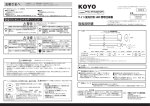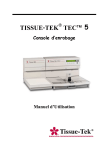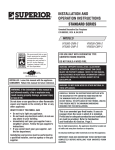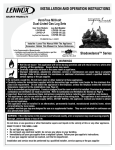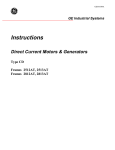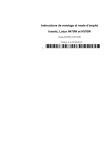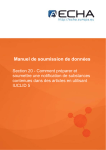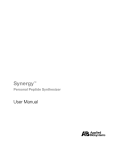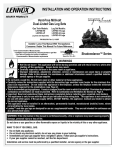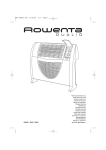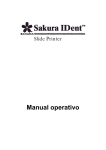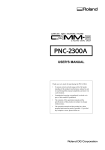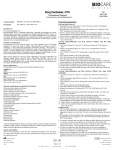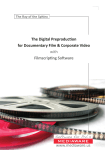Download neutralex user`s guide
Transcript
© 2013 Sakura Finetek USA, Inc. All Rights Reserved Printed in U.S.A. Manufactured for: Sakura Finetek USA, Inc., Torrance, CA 90501 U.S.A. Sakura Finetek Japan Co., Ltd., Tokyo, 135-0007, Japan Sakura Finetek Europe B.V., 2408 AV Alphen aan den Rijn, NL 0003372-01 Rev.B TABLE OF CONTENTS Section 1 Page INTRODUCTION Intended Use ................................................................................................................................................ 1.1 Aldehyde Neutralizing Agent......................................................................................................................... 1.1 2 PROCEDURES FOR NEUTRALEX Tissue-Tek Neutralex NCCLS Formatted Procedure for 10% Formalin, VIP Fixative and 2% or 4% Glutaraldeyde .............................................................................................................................................. 2.1 Tissue-Tek Neutralex Procedure for Neutralizing 37% Formaldeyde ............................................................ 2.3 Tissue-Tek Neutralex Procedure for Neutralizing Alcoholic Formalin............................................................ 2.3 Tissue-Tek Neutralex Procedure for Neutralizing Pen-Fix ............................................................................. 2.4 Tissue-Tek Neutralex Procedure for Neutralizing Surgipath Decalcifier ........................................................ 2.5 3 Tissue-Tek Neutralex Material Safety Data Sheets Tissue-Tek Neutralex, Neutra-Form, Neutra-Pads, Neutra-Wipes, Neutralex Adheyde Test Kit .................... 3.1 4 CAL/EPA Technology Certification Certificate ..................................................................................................................................................... 4.1 5 Applications and Illustrated Procedures For All Neutra-Guard Products Product Applications and Procedures........................................................................................................... 5.1 Neutra-Guard Aldehyde Control System ...................................................................................................... 5.1 6 Aldehyde Waste Treatment Log Log Sheet ..................................................................................................................................................... 6.1 Revised 06/18/2013 iii iv Revised 06/18/2013 INTRODUCTION Section 1 Intended Use ® ® The Tissue-Tek Neutralex Aldehyde Control System is designed to neutralize formalin waste. Aldehyde Neutralizing Agent As we settle into a new millennium, the public concern for safe disposal of hazardous chemicals has become a national mandate. Formaldehyde and glutaraldehyde disposal has become increasingly regulated by federal, state, and local agencies. The challenge being posed is for safe, effective remediation while keeping a watchful eye on cost containment. In response to this challenge, Sakura Finetek is pleased to offer a safe, effective, and economical solution for the drain disposal of most aldehyde solutions. Neutralex® technology offers this and so many other unique features: • The ONLY Cal/EPA certified technology for the treatment of formaldehyde • Complete neutralization in 15 minutes • Reaction does not produce any drain clogging polymer by-products • No pH adjustment required prior to disposal • No messy liquids; the easy-to-use powder form is conveniently packaged in pre-measured pouches • Reaction is irreversible and environmentally safe In addition to providing the necessary documents to support the use of Neutralex, this User’s Handbook also offers information on other aldehyde control products that comprise the Neutra-Guard system. Neutralex is only one product in this system and as you will learn in Section 5, the combined use of all Neutra-Guard products present viable solutions for the safe management of aldehyde disposal and vapor control. Revised 06/18/2013 1.1 INTRODUCTION 1.2 Revised 06/18/2013 PROCEDURES FOR NEUTRALEX Tissue-Tek® Neutralex® NCCLS Formatted Procedure for 10% Formalin, VIP Fixative, and 2% or 4% Glutaraldehyde NAME DATE Solutions to be Neutralized 10% formalin, VIP Fixative®, or 2% glutaraldehyde Equipment − − − Adopted ® Section 2 Tissue-Tek® Reaction Container (2.5 gallon, Sakura Product Code 4276) Tissue-Tek® Aldehyde Test Kit™ (Sakura Product Code 4050) pH Test Strips Reagents Reviewed Tissue-Tek® Neutralex® Aldehyde Neutralization Agent (Sakura Product Code 4047) Reviewed Procedure Reviewed Reviewed Reviewed Principle ® ® The Tissue-Tek Neutralex aldehyde neutralization technology was designed to treat aldehydic wastewater in a batch-processing mode. The spent aldehydic solutions are transferred to a collection vessel and treated with a pre-measured amount of Tissue-Tek® Neutralex® to render a non-hazardous liquid waste. After being tested with the Tissue-Tek® Aldehyde Test Kit™, the solution may then be disposed of as a non-hazardous waste and discharged to the sanitary sewer. Analytical data on the reaction byproducts indicates that this non-hazardous waste has the following characteristics: water-white color, no residual aldehydic odor, no solid polymer waste and no turbidity problems. Revised 06/18/2013 1. Refer to manufacturer's MSDS for the safe handling of 10% formalin, VIP Fixative®, or 2% glutaraldehyde utilizing OSHA mandated protective equipment such as safety goggles, gloves, and an impervious apron. 2. For aldehyde neutralization, first separate all of the identifiable tissue specimens from the liquid hazardous waste. This shall be performed using an appropriate screen mesh (#80 mesh is recommended) and collecting the aldehydic waste in a calibrated reaction vessel such as the TissueTek® Reaction Container (Sakura Product Code 4276). Volumetric calibration can be in gallon or liter divisions. 3. NOTE: The neutralization procedure should be performed in an OSHA or AIHA approved ventilated room or under an adequate hood. The reaction vessel should be placed in any receptacle providing secondary containment such as a plastic tub, closed sink, etc. A counter top lined with TissueTek® Neutra-Wipes® (Sakura Product Code 4279) would also suffice as an acceptable means of secondary containment. 4. Just prior to neutralization, test the aldehyde waste for pH and record the results in a Hazardous Waste Log (refer to step 10). Be sure that the aldehyde solution being neutralized does not have a pH of 4 or less. 2.1 PROCEDURES FOR NEUTRALEX® 5. Determine the total volume of Tissue-Tek® Neutralex® required for the detoxification of the aldehyde waste by using the following procedure: Determine the total volume of 10% formalin or 2% glutaraldehyde waste present. Use one pouch of Tissue-Tek® Neutralex® for each gallon of 10% formalin or two gallons of 2% glutaraldehyde waste. Pour the complete contents of each pouch into the calibrated reaction vessel containing the waste. Shake, stir, or swirl the mixture for five to ten seconds. 6. Cap the vessel and let it stand for 15 minutes. Swirl once again prior to testing. 7. Using a pipette, extract 5 ml of treated waste from the vessel and transfer it to the plastic cuvette that is supplied in the Tissue-Tek® Aldehyde Test Kit™ (Sakura Product Code 4050). There is a 5-ml line already printed on the cuvette. Test the pH by using ordinary laboratory pH strips. Record the results in a Hazardous Waste Log (refer to step 10). After completing this, save the contents of the cuvette and test for residual aldehyde using the TissueTek® Aldehyde Test Kit™. The procedure is discussed in step 8. 8. Using the same cuvette from step 7 that is still filled with the treated waste, perform the residual aldehyde test as follows: a. Remove an Aldehyde test strip from the vial provided in the kit. b. Immerse the reaction zone of the test strip into the solution for 20 seconds. c. Shake off the excess liquid from the strip then compare the reaction zone color of the strip to the color scale on the side of the bottle. d. The matching color will designate a number. This is the residual aldehyde content in ppm of the treated formalin. e. Record these results in the Hazardous Waste Log that is discussed in step 10. 10. Discard detoxified aldehydic waste to a sanitary sewer system in accordance with your local Publicly Owned Treatment Works (POTW) discharge requirements. It is important that you keep a log indicating the date of neutralization, the employee that performed the procedure, the volume of aldehydic waste treated, and the analytical results of the neutralization. A sample copy of this log can be found in Section 6 of the Neutralex® User’s Handbook. Results After the 15-minute neutralization period is complete, the resulting solution will have been neutralized and ready for disposal in accordance to the institutions wastewater permit or the local POTW. Quality Control The neutralized solution should be verified for pH and residual aldehyde concentrations. Aldehyde concentrations can be verified by using the Tissue-Tek® Aldehyde Test Kit™ described in steps 7 and 8 of the procedure section. References Luna, Lee G., Histopathological Methods and Color Atlas of Special Stains and Tissue Artifacts, American Histolabs, Inc., Publishing Division, 1992 California Environmental Agency, Department of Toxic Substances Control, Hazardous Waste Performance Certificate, July, 1995 NOTE: For additional work practice controls in neutralizing formalin spills and eliminating harmful vapors while performing grossing procedures, please refer to Section 5 of this manual for more information on Neutra-Pads®, Neutra-Wipes®, and Neutra-Form®. 9. If your aldehydic waste solution contains zinc ions, a precipitate consisting of zinc hydroxide and other oxides will form. The concentration of these precipitates will be measured in ppms. Although these precipitates are generally considered nonhazardous for disposal, they should be removed by filtration. This can be accomplished by using glass wool or a coffee filter. The precipitate may be discarded or recycled. 2.2 Revised 06/18/2013 Tissue-Tek® Neutralex® Procedure for Neutralizing 37% Formaldehyde Operating Procedure Instructions for the neutralization of 37% Formaldehyde 1. Refer to the manufacturer’s MSDS for the safe handling of glutaraldehyde and OSHA mandated protective equipment (e.g., safety goggles, gloves, impervious apron, etc.). 2. For aldehyde neutralization, all identifiable tissue must be separated from the liquid hazardous waste. This shall be performed using the proper screen (e.g., 80 mesh). The liquid aldehydic waste is then collected in a calibrated reaction vessel. Volumetric calibration can be in gallon or liter divisions, preferably gallons. 3. Reduce the concentration of the 37% formaldehyde by diluting it as follows: 1 part formaldehyde to 9 parts water. The concentration of formaldehyde should now be in the 10% range, which is the normal concentration for any working formalin solution. The remainder of the neutralization procedure is identical to the procedure outlined in the NCCLS format for 10% formalin. Tissue-Tek® Neutralex® Procedure for Neutralizing Alcoholic Formalin The following is the procedure for neutralizing 10% alcoholic formalin with Tissue-Tek® Neutralex®. There are three basic changes that represent a deviation from the normal procedure for neutralizing just 10% neutral buffered formalin. First, the reaction time will be increased from 15 to 90 minutes. Second, an equal amount of water will be added to the volume of alcoholic formalin to be neutralized. The last change takes place in the Aldehyde Test Kit™ procedure. Revised 06/18/2013 Operating Procedure Instructions for the Neutralization of Alcoholic Formalin 1. Refer to the manufacturer’s MSDS for the safe handling of 10% alcoholic formalin and OSHA mandated protective equipment (e.g., safety goggles, gloves, impervious apron, etc.). 2. For aldehyde neutralization, all identifiable tissue must be separated from the liquid hazardous waste. This shall be performed using the proper screen (e.g., 80 mesh). The liquid aldehydic waste is then collected in a calibrated reaction vessel. Volumetric calibration can be in gallon or liter divisions, preferably gallons. 3. Calculate the volume of Tissue-Tek® Neutralex® required to neutralize the aldehyde waste by using the following procedure. Determine the total volume in whole gallons or liters of 10% alcoholic formalin to be neutralized. Use one pouch of Tissue-Tek® Neutralex® per gallon or liter of aldehydic waste. Pour the complete contents of each pouch into the calibrated reaction vessel. 4. Add an equal amount of water to the reaction vessel. For example, if one gallon of alcoholic formalin is to be treated add one gallon of water. Two gallons of waste, two gallons of water. Shake or stir the mixture for fifteen seconds. 5. Cap the vessel and let it stand for 90 minutes. 6. Test the neutralized waste solution for residual aldehyde. Residual Aldehyde Test Procedure a. Rinse the test vessel with the sample solution and fill to the 5mL mark. b. Immerse the reaction zone of the Aldehyde test strip into the solution for 20 seconds. c. Shake off excess liquid from the strip then compare the reaction zone with color scale. 2.3 PROCEDURES FOR NEUTRALEX® Tissue-Tek® Neutralex® Procedure for Neutralizing Pen-Fix The following is the procedure for neutralizing Pen-Fix with Tissue-Tek® Neutralex®. There are three basic changes that represent a deviation from the normal procedure for neutralizing Pen-Fix Fixative. First, the reaction time will be increased from 15 to 90 minutes. Second, an equal amount of water will be added to the volume of Pen-Fix to be neutralized. Third, two packets of Neutralex® are required to neutralize one gallon of the Pen-Fix. The changes are implemented in the following procedure: Residual Aldehyde Test Procedure a. Rinse the test vessel with the sample solution and fill to the 5mL mark. b. Immerse the reaction zone of the Aldehyde test strip into the solution for 20 seconds. c. Shake off excess liquid from the strip then compare the reaction zone with color scale. Operating Procedure Instructions for the Neutralization of Pen-Fix 1. Refer to the manufacturer’s MSDS for the safe handling of 10% alcoholic formalin and OSHA mandated protective equipment (e.g., safety goggles, gloves, impervious apron, etc.). 2. For Pen-Fix treatment, all identifiable tissue must be separated from the liquid hazardous waste. This shall be performed using the proper screen (e.g., 80 mesh). The liquid aldehydic waste is then collected in a calibrated reaction vessel. Volumetric calibration can be in gallon or liter divisions, preferably gallons. 3. Calculate the volume of Tissue-Tek® Neutralex® required to neutralize the Pen-Fix waste by using the following procedure: determine the total volume in whole gallons of Pen-Fix to be neutralized. Use TWO pouches of Tissue-Tek® Neutralex® per gallon of Pen-Fix waste. Pour the complete contents of each pouch into the calibrated reaction vessel. 4. Add an equal amount of water to the reaction vessel. For example, if one gallon of Pen-Fix is to be treated, add one gallon of water. Two gallons of waste, two gallons of water. Shake or stir the mixture for fifteen or twenty seconds until the Neutralex® is dissolved. 5. Cap the vessel and let it stand for 90 minutes. 6. Test the neutralized Pen-Fix waste solution for residual aldehyde as outlined below: 2.4 Revised 06/18/2013 Tissue-Tek® NEUTRALEX® Procedure for Neutralizing Surgipath Decalcifier I The following is the procedure for neutralizing Surgipath Decalcifier with Tissue-Tek® Neutralex®. There are two basic changes that represent a deviation from the normal Neutralex® procedure. First, 10% sodium hydroxide is added to neutralize the formic acid. Secondly, the Decalcifier waste volume has been reduced to ¾ gallon per pouch of Neutralex®. These changes are implemented in the following procedure: Residual Aldehyde Test Procedure: a. Rinse the test vessel with the sample solution and fill to the 5mL mark. b. Immerse the reaction zone of the Aldehyde test strip into the solution for 20 seconds. c. Shake off excess liquid from the strip then compare the reaction zone with color scale. Operating Procedure Instructions for the neutralization of Surgipath Decalcifier Solution 1. Refer to the manufacturer’s MSDS for the safe handling of 10% alcoholic formalin and OSHA mandated protective equipment (e.g., safety goggles, gloves, impervious apron, etc.). 2. For Decalcifier treatment, all identifiable tissue must be separated from the liquid hazardous waste. This shall be performed using the proper screen (e.g., 80 mesh). The liquid aldehydic waste is then collected in a calibrated reaction vessel. Volumetric calibration can be in gallon or liter divisions, preferably gallons. 3. Add ¾ of a gallon of Decalcifier waste to the calibrated reaction container. 4. Add 1-1/3 gallons of 10% sodium hydroxide to the reaction container. Mix solution for 15 seconds and let stand 1 minute. 5. Add one pouch of Tissue-Tek® Neutralex® to the reaction container. Pour the complete contents of the pouch into the calibrated reaction vessel and mix for 15 seconds. 6. Cap the vessel and let it stand for 15 minutes. 7. Test the neutralized Decalcifier waste solution for residual aldehyde as outlined below: Revised 06/18/2013 2.5 PROCEDURES FOR NEUTRALEX® 2.6 Revised 06/18/2013 MATERIAL SAFETY DATA SHEETS ® Section 3 Tissue-Tek® Neutralex® Material Safety Sheets Tissue-Tek® Neutralex® h4047 TissueTek® Neutra-Form® h4304 Tissue Tek® Neutra-Pads® h4295 Tissue-Tek® Neutra-Wipes® h4728 & h4729 Tissue-Tek® Neutralex Aldehyde Test Kit™ Revised 06/18/2013 3.1 MATERIAL SAFETY DATA SHEET (In accordance with ISO 11014:2009 Standard) MSDS#: 0002144-02 Rev: D Revision Date: 09/17/12 Original Preparation Date: 12/01/08 1. Chemical Product and Company Identification Product Name: Tissue-Tek® NEUTRALEX® – (product code #4047) Synonym(s): N/A Recommended Uses: N/A Manufactured For: Sakura Finetek USA, Inc. Torrance, CA 90501 USA Tel: 310-972-7800 Emergency Telephone Number: 800-424-9300 (Chemtrec) 2. Hazards Identification EMERGENCY OVERVIEW DANGER: Contact with acid solution of pH less than 4 releases sulfur dioxide gas which may be harmful or deadly if inhaled. Health Effects: May cause severe or deadly allergic reactions in some asthmatic and sulfur sensitive individuals. Inhalation of dust or mist can irritate the respiratory tract. Possible signs and symptoms of allergic reactions include bronchoconstriction, sweating, flushing, hives, rapid heart rate, decreased blood pressure, and anaphylaxis. May irritate gastrointestinal tract. Very large doses cause death, violent colic, diarrhea, and depression. May cause severe or deadly allergic reaction in some asthmatic and sulfur sensitive individuals. HMIS Rating Health: Flammability: Reactivity: Protection : HMIS Rating Scale 2 0 0 N/A HMIS Rating Notes: Protection = See section 8 Minimal: Slight: Moderate: High: Severe: 0 1 2 3 4 3. Composition/Information on Ingredients Hazardous Component Specific Chemical Identity CAS # % WEIGHT NIOSH or OSHA ACGIH TLV Trade secret-chemical identity withheld Trade secret Trade secret 5 mg/m3 5 mg/m3 4. First-Aid Measures Inhalation: The patient should be transported away from exposure and brought to fresh air. If necessary administer CPR, keep warm and quiet. Seek immediate medical attention. Skin Contact: Contaminated clothing should be removed immediately. The affected body areas should be flushed with water for a period of approximately 15 minutes. If symptoms persist, seek medical attention. Eye Contact: Do not allow victim to rub or keep eyes tightly shut. Flush eyes immediately with water for 10 - 15 minutes. If burning persists, seek medical care. Ingestion: Give plenty of water or milk to drink. If conscious, induce vomiting by touching finger to back of throat. Get immediate medical attention. Never give anything by mouth to an unconscious person. 5. Fire-Fighting Measures Extinguishing Media: Water fog, regular foam, dry chemicals, or carbon dioxide. Fire/Explosion Hazards: N/A Fire Fighting Procedures: Wear self-contained breathing apparatus with full body protection. Sensitivity to Static Discharge: N/A Hazardous Decomposition Products: Sulfur oxides can be generated upon adding or mixing with acids. Store the product away from acids and oxidizers. Flash Point and Method: Noncombustible Flammable Limits: N/A Auto Ignition Temperature: N/A 6. Accidental Release Measures Personal Precautions: N/A Protective Equipment: N/A Emergency Procedures: N/A Environmental Precautions: N/A Methods and Materials for Containment: N/A Methods and Materials for Cleaning Up: With clean dry shovel, carefully place material into clean, dry container and cover; remove from area. Flush spill area with water. 7. Handling and Storage Handling: N/A Storage: Suitable for any general chemical storage area. All electrical equipment in storage and/or handling areas should be installed in accordance with applicable requirements of the National Electrical Code (NEC). 8. Exposure Controls and Personal Protection Permissible concentration: N/A Engineering Controls: N/A PERSONAL PROTECTIVE EQUIPMENT Respiratory Protection: General mechanical or local exhaust should be used to maintain low exposure levels. Avoid prolonged periods of directly breathing vapors. In absence of proper environmental controls, the use of a NIOSH/OSHA respirator is recommended. Respirator use should comply with OSHA 29 CFR 1910.134. Hand Protection: Use appropriate resistant gloves Eye Protection: Chemical splash goggles Skin and Body Protection: Normal laboratory work clothing covering arms and legs. Protective Clothing: Normal laboratory work clothing covering arms and legs. 9. Physical and Chemical Properties Appearance: White Powder Odor: N/A pH: 6.5 - 7.0 Melting Point: N/A Freezing Point: N/A Boiling Point: N/A Flash Point: N/A Vapor Pressure: N/A Vapor Density: N/A Density / Relative Density: N/A Solubility: N/A n-Octano/Water Partition Coefficient: N/A Auto-Ignition Temperature: N/A Decomposition Temperature: N/A Odor Threshold: N/A Evaporation Rate: N/A Flammability: N/A Viscosity: N/A Percent Volatile by Volume: N/A Specific Gravity: Greater than water 10. Stability and Reactivity Conditions to Avoid: N/A Incompatible Materials: Avoid contact with strong oxidizing agents and acids. Mixing with acids, it can generate sulfur dioxide. Stability: Stable Hazardous Decomposition Products: N/A Hazardous Polymerization: Cannot occur 11. Toxicological Information Acute Toxicity: N/A Skin Irritation/Corrosion (Burning): Exposure causes skin irritation, redness, and burning. Pre-existing skin conditions could be aggravated. Absorption through skin is unlikely. Eye Damage/Irritation: Depending on the quantity that comes in contact with an eye, the injuries sustained may range from mild irritation to redness and burning. Respiratory or Skin Sensitization: N/A Reproductive Cell Mutagenicity: N/A Carcinogenicity: The ingredients in this product are not carcinogenic. None of the ingredients of this product are listed in California’s Proposition 65, or IRAC list of carcinogens. Reproductive Toxicity: N/A Specific Target Organ Toxicity – single exposure: N/A Specific Target Organ Toxicity – repeated exposure: N/A Aspiration (Inhalation) Hazard: Dust can cause irritation of nasal and respiratory passages. Wear a NIOSH approved respirator when working with chemicals, unless work is conducted in a ventilated hood. Ingestion: Single dose oral toxicity is moderate. Symptoms may include stomach irritation, nausea, and diarrhea. 12. Ecological Information Ecotoxicity: Aquatic Bioassay was conducted using guidelines prescribed in “Static Acute Bioassay Procedure for Hazardous Waste for Samples,” result status = pass, 96 hour LC50 > 750 mg/l. This product is within the allowable limits specified in 40 CFR 261 and 433.11, California Soluble Threshold Limit Concentrations (STLCs) and Total Threshold Limit Concentration (TTLCs) and is considered a non-hazardous material. Persistence and Degradability: N/A Bioaccumulative Potential: N/A Mobility in Soil: N/A 13. Disposal Considerations Disposal Method: Dispose of in accordance with all applicable local, state, and federal regulations. 14. Transport Information UN Number: N/A UN Proper Shipping Name: N/A UN Classification: N/A Marine Pollutant (Y/N): N/A OTHER SHIPPING INFORMATION: N/A Markings: N/A Hazardous Substance/RQ: N/A SPECIAL SHIPPING NOTES: N/A IMDG: N/A IATA: N/A DOT Shipping Number: None Regulated DOT Hazard Classification: None Regulated 15. Regulatory Information UNITED STATES SARA Title III (Superfund Amendments and Reauthorization Act) SARA Title III Sect. 302 Extremely Hazardous Substances (40 CFR 355): Not listed SARA Title III Sect. 313 Reportable Ingredients (40 CFR 372.65): Not listed CERCLA (Comprehensive Environmental Response Compensation and Liability Act): Not listed RCRA Hazardous Waste (40 CFR 261.33): Not listed STATE REGULATIONS Proposition 65: This product does not contain any PROP 65 compounds that are known to cause cancer or birth defects. 16. Other Information This Material Safety Data Sheet has been furnished on request. A revised Material Safety Data Sheet will be furnished only if requested, also in case of specification changes. The above information, which is accurate to the best of our knowledge and belief, describes the safety aspects of our product but does not warrant any product properties. The company gives no warranty as to the accuracy or completeness of such information. MATERIAL SAFETY DATA SHEET (In accordance with ISO 11014:2009 Standard) MSDS#: 0003383-01 Rev: D Revision Date: 09/17/12 Original Preparation Date: 12/01/08 1. Chemical Product and Company Identification Product Name: Tissue-Tek® NEUTRA-FORM®– (product code #4304) Synonym(s): N/A Recommended Uses: N/A Manufactured For: Sakura Finetek USA, Inc. Torrance, CA 90501 USA Tel: 310-972-7800 Emergency Telephone Number: 800-424-9300 (Chemtrec) 2. Hazards Identification EMERGENCY OVERVIEW DANGER: N/A Health Effects: N/A Primary Entry Routes: Inhalation and eye contact Target organs: Respiratory tract, eyes Carcinogenicity: IARC, NTP, and OSHA do not list chemical ingredients as a carcinogen HMIS Rating Health: Flammability: Reactivity: Protection : HMIS Rating Scale 1 0 0 N/A HMIS Rating Notes: Protection = N/A Minimal: Slight: Moderate: High: Severe: 0 1 2 3 4 3. Composition/Information on Ingredients Hazardous Component Specific Chemical Identity CAS # % WEIGHT NIOSH or OSHA ACGIH TLV Trade secret-chemical identity withheld Trade secret Trade secret 5 mg/m3 5 mg/m3 4. First-Aid Measures Inhalation: The patient should be transported away from exposure and brought to fresh air. If necessary administer CPR, keep warm and quiet. Seek immediate medical attention. Skin Contact: Contaminated clothing should be removed immediately. The affected body areas should be flushed with water for a period of approximately 15 minutes. If symptoms persist, seek medical attention. Eye Contact: Flush eyes immediately with water for 10 - 15 minutes. If burning persists, seek medical care. Ingestion: Induce vomiting to conscious victims and seek medical attention. Unconscious victims should be placed on their left side with their head down. Do not induce vomiting. 5. Fire-Fighting Measures Extinguishing Media: Water fog, regular foam, dry chemicals or carbon dioxide Fire/Explosion Hazards: N/A Fire Fighting Procedures: Wear self-contained breathing apparatus with full body protection Sensitivity to Static Discharge: N/A Hazardous Decomposition Products: None Flash Point and Method: Greater than 200º F Flammable Limits: N/A Auto Ignition Temperature: N/A 6. Accidental Release Measures Personal Precautions: N/A Protective Equipment: N/A Emergency Procedures: N/A Environmental Precautions: N/A Methods and Materials for Containment: N/A Methods and Materials for Cleaning Up: With clean dry shovel, carefully place material into clean, dry container and cover; remove from area. Flush spill area with water. 7. Handling and Storage Handling: All electrical equipment in storage and/or handling areas should be installed in accordance with applicable requirements of the National Electrical Code (NEC). Storage: Suitable for any general chemical storage area. 8. Exposure Controls and Personal Protection Permissible concentration: N/A Engineering Controls: N/A PERSONAL PROTECTIVE EQUIPMENT Respiratory Protection: General mechanical or local exhaust should be used to maintain low exposure levels. Avoid prolonged periods of directly breathing vapors. In absence of proper environmental controls, the use of a NIOSH/OSHA respirator is recommended. Respirator use should comply with OSHA 29 CFR 1910.134. Hand Protection: Use appropriate resistant gloves. Eye Protection: Use chemical splash goggles. Skin and Body Protection: N/A Protective Clothing: Use normal laboratory work clothing covering arms and legs. 9. Physical and Chemical Properties Appearance: Whitish powder Odor: N/A pH: After Neutralization > 6 Melting Point: N/A Freezing Point: N/A Boiling Point: N/A Flash Point: N/A Vapor Pressure: N/A Vapor Density: N/A Density / Relative Density: N/A Solubility: N/A n-Octano/Water Partition Coefficient: N/A Auto-Ignition Temperature: N/A Decomposition Temperature: N/A Odor Threshold: N/A Evaporation Rate: N/A Flammability: N/A Viscosity: N/A Specific Gravity: Greater than water Percent Volatile by Volume: N/A 10. Stability and Reactivity Conditions to Avoid: Strong oxidixing agents. Incompatible Materials: Avoid contact with strong mineral acids and strong oxidixing agents. Stability: Stable Hazardous Decomposition Products: N/A Hazardous Polymerization: Cannot occur 11. Toxicological Information Acute Toxicity: N/A Skin Irritation/Corrosion (Burning): Exposure causes skin irritation, redness, and burning. Pre-existing skin conditions could be aggravated. Absorption through skin is unlikely. Eye Damage/Irritation: Depending on the quantity that comes in contact with an eye, the injuries sustained may range from mild irritation to redness and burning. Respiratory or Skin Sensitization: N/A Reproductive Cell Mutagenicity: N/A Carcinogenicity: IARC, NTP, and OSHA do not list chemical ingredients as a carcinogen Reproductive Toxicity: N/A Specific Target Organ Toxicity – single exposure: (Ingestion) Single dose oral toxicity is moderate. Symptoms may include stomach irritation, nausea, and diarrhea. Specific Target Organ Toxicity – repeated exposure: N/A Aspiration (Inhalation) Hazard: Dust can cause irritation of nasal and respiratory passages. 12. Ecological Information Aquatic Bioassay was conducted using guidelines prescribed in “Static Acute Bioassay Procedure for Hazardous Waste for Samples,” result status = pass, 96 hour LC50 > 750 mg/l. NEUTRA-FORM® is within the allowable limits specified in 40 CFR 261 and 433.11, California Soluble Threshold Limit Concentrations (STLCs) and Total Threshold Limit Concentration (TTLCs) and is considered a non-hazardous material. Ecotoxicity: N/A Persistence and Degradability: N/A Bioaccumulative Potential: N/A Mobility in Soil: N/A 13. Disposal Considerations Disposal Method: Dispose of in accordance with all applicable local, state, and federal regulations. 14. Transport Information UN Number: N/A UN Proper Shipping Name: N/A UN Classification: N/A Marine Pollutant (Y/N): N/A OTHER SHIPPING INFORMATION: N/A Markings: N/A Hazardous Substance/RQ: N/A SPECIAL SHIPPING NOTES: N/A IMDG: N/A IATA: N/A DOT Shipping Number: None Assigned DOT Hazard Classification: None Assigned 15. Regulatory Information UNITED STATES SARA Title III (Superfund Amendments and Reauthorization Act) SARA Title III Sect. 302 Extremely Hazardous Substances (40 CFR 355): Not listed SARA Title III Sect. 313 Reportable Ingredients (40 CFR 372.65): Not listed CERCLA (Comprehensive Environmental Response Compensation and Liability Act): Not listed RCRA Hazardous Waste (40 CFR 261.33): Not listed STATE REGULATIONS Proposition 65: Not listed 16. Other Information This Material Safety Data Sheet has been furnished on request. A revised Material Safety Data Sheet will be furnished only if requested, also in case of specification changes. The above information, which is accurate to the best of our knowledge and belief, describes the safety aspects of our product but does not warrant any product properties. The company gives no warranty as to the accuracy or completeness of such information. MATERIAL SAFETY DATA SHEET (In accordance with ISO 11014:2009 Standard) MSDS#: 0003384-01 Rev: D Revision Date: 09/17/12 Original Preparation Date: 12/01/08 1. Chemical Product and Company Identification Product Name: Tissue-Tek® NEUTRA-PADS® Synonym(s): N/A Recommended Uses: N/A Manufactured For: Sakura Finetek USA, Inc. Torrance, CA 90501 USA Tel: 310-972-7800 Emergency Telephone Number: 800-424-9300 (Chemtrec) 2. Hazards Identification EMERGENCY OVERVIEW DANGER: N/A Health Effects: N/A Primary Entry Routes: Inhalation and eye contact Target organs: Respiratory tract, eyes Carcinogenicity: IARC, NTP, and OSHA do not list chemical ingredients as a carcinogen HMIS Rating Health: Flammability: Reactivity: Protection : HMIS Rating Scale 1 0 0 N/A HMIS Rating Notes: Protection = N/A Minimal: Slight: Moderate: High: Severe: 0 1 2 3 4 3. Composition/Information on Ingredients Hazardous Component Specific Chemical Identity CAS # % WEIGHT NIOSH or OSHA ACGIH TLV Trade secret-chemical identity withheld Trade secret Trade secret 5 mg/m3 5 mg/m3 4. First-Aid Measures Inhalation: The patient should be transported away from exposure and brought to fresh air. If necessary administer CPR, keep warm and quiet. Seek immediate medical attention. Skin Contact: Contaminated clothing should be removed. The affected body areas should be flushed with water for a period of approximately 15 minutes. If symptoms persist, seek medical attention. Eye Contact: Flush eyes immediately with water for 10 - 15 minutes. If burning persists, seek medical care. Ingestion: Do not induce vomiting. Drink water or milk. Continue ingesting fluids until medical help is obtained. Unconscious victims should be placed on their left side with their head down. Do not induce vomiting. 5. Fire-Fighting Measures Extinguishing Media: Water fog, regular foam, dry chemicals, or carbon dioxide. Fire/Explosion Hazards: N/A Fire Fighting Procedures: Wear self-contained breathing apparatus with full body protection. Sensitivity to Static Discharge: N/A Hazardous Decomposition Products: None Flash Point and Method: N/A Flammable Limits: N/A Auto Ignition Temperature: N/A 6. Accidental Release Measures Personal Precautions: N/A Protective Equipment: N/A Emergency Procedures: N/A Environmental Precautions: N/A Methods and Materials for Containment: N/A Methods and Materials for Cleaning Up: N/A 7. Handling and Storage Handling: All electrical equipment in storage and/or handling areas should be installed in accordance with applicable requirements of the National Electrical Code (NEC). Storage: Suitable for any general storage area. 8. Exposure Controls and Personal Protection Permissible concentration: N/A Engineering Controls: N/A PERSONAL PROTECTIVE EQUIPMENT Respiratory Protection: General office or laboratory ventilation. Hand Protection: Use of gloves is suggested. Eye Protection: N/A Skin and Body Protection: N/A Protective Clothing: N/A 9. Physical and Chemical Properties Appearance: Blue-White Cloth Odor: N/A pH: N/A Melting Point: N/A Freezing Point: N/A Boiling Point: N/A Flash Point: N/A Vapor Pressure: N/A Vapor Density: N/A Density / Relative Density: N/A Solubility: N/A n-Octano/Water Partition Coefficient: N/A Auto-Ignition Temperature: N/A Decomposition Temperature: N/A Odor Threshold: N/A Evaporation Rate: N/A Flammability: N/A Viscosity: N/A Specific Gravity: N/A Percent Volatile by Volume: N/A 10. Stability and Reactivity Conditions to Avoid: N/A Incompatible Materials: Strong oxidizers Stability: Stable Hazardous Decomposition Products: N/A Hazardous Polymerization: Cannot occur 11. Toxicological Information Acute Toxicity: N/A Skin Irritation/Corrosion(Burning): Excessive exposure may cause mild skin irritation. Pre-existing skin conditions could be aggravated. Absorption through skin is unlikely. Eye Damage/Irritation: Depending on the quantity that comes in contact with an eye, the injuries sustained may range from mild irritation to redness and burning. Respiratory or Skin Sensitization: N/A Reproductive Cell Mutagenicity: N/A Carcinogenicity: N/A Reproductive Toxicity: N/A Specific Target Organ Toxicity – single exposure: (Ingestion) Single dose oral toxicity is slight. Symptoms may include stomach irritation, nausea, and diarrhea. Specific Target Organ Toxicity – repeated exposure: N/A Aspiration (Inhalation) Hazard: No reported effects. 12. Ecological Information Aquatic Bioassay was conducted using guidelines prescribed in “Static Acute Bioassay Procedure for Hazardous Waste for Samples,” result status = pass, 96 hour LC50 > 750 mg/l. Ecotoxicity: N/A Persistence and Degradability: N/A Bioaccumulative Potential: N/A Mobility in Soil: N/A 13. Disposal Considerations Disposal Method: Dispose of in accordance with all applicable local, state, and federal regulations. 14. Transport Information UN Number: N/A UN Proper Shipping Name: N/A UN Classification: N/A Marine Pollutant (Y/N): N/A OTHER SHIPPING INFORMATION: N/A Markings: N/A Hazardous Substance/RQ: N/A SPECIAL SHIPPING NOTES: N/A IMDG: N/A IATA: N/A DOT Shipping Number: None Assigned DOT Hazard Classification: None Assigned 15. Regulatory Information UNITED STATES SARA Title III (Superfund Amendments and Reauthorization Act) SARA Title III Sect. 302 Extremely Hazardous Substances (40 CFR 355): Not listed SARA Title III Sect. 313 Reportable Ingredients (40 CFR 372.65): Not listed CERCLA (Comprehensive Environmental Response Compensation and Liability Act): Not listed RCRA Hazardous Waste (40 CFR 261.33): Not listed STATE REGULATIONS Proposition 65: Not listed 16. Other Information This Material Safety Data Sheet has been furnished on request. A revised Material Safety Data Sheet will be furnished only if requested, also in case of specification changes. The above information, which is accurate to the best of our knowledge and belief, describes the safety aspects of our product but does not warrant any product properties. The company gives no warranty as to the accuracy or completeness of such information. MATERIAL SAFETY DATA SHEET (In accordance with ISO 11014:2009 Standard) MSDS#: 0003385-01 Rev: D Revision Date: 09/17/12 Original Preparation Date: 12/01/08 1. Chemical Product and Company Identification Product Name: Tissue-Tek® NEUTRA-WIPES® – (product codes #4278 and #4279) Synonym(s): N/A Recommended Uses: N/A Manufactured For: Sakura Finetek USA, Inc. Torrance, CA 90501 USA Tel: 310-972-7800 Emergency Telephone Number: 800-424-9300 (Chemtrec) 2. Hazards Identification EMERGENCY OVERVIEW DANGER: N/A Health Effects: N/A Primary Entry Routes: Inhalation and eye contact Target organs: Respiratory tract, eyes Carcinogenicity: IARC, NTP, and OSHA do not list chemical ingredients as a carcinogen. HMIS Rating Health: Flammability: Reactivity: Protection : HMIS Rating Scale 1 0 0 N/A HMIS Rating Notes: Protection = N/A Minimal: Slight: Moderate: High: Severe: 0 1 2 3 4 3. Composition/Information on Ingredients Hazardous Component Specific Chemical Identity CAS # % WEIGHT NIOSH or OSHA ACGIH TLV Trade secret-chemical identity withheld Trade secret Trade secret 5 mg/m3 5 mg/m3 4. First-Aid Measures Inhalation: The patient should be transported away from exposure and brought to fresh air. If necessary administer CPR, keep warm and quiet. Seek immediate medical attention. Skin Contact: Contaminated clothing should be removed. The affected body areas should be flushed with water for a period of approximately 15 minutes. If symptoms persist, seek medical attention. Eye Contact: Flush eyes immediately with water for 10 - 15 minutes. If burning persists, seek medical care. Ingestion: Do not induce vomiting. Drink water or milk. Continue ingesting fluids until medical help is obtained. Unconscious victims should be placed on their left side with their head down. Do not induce vomiting. 5. Fire-Fighting Measures Extinguishing Media: Water fog, regular foam, dry chemicals, or carbon dioxide Fire/Explosion Hazards: N/A Fire Fighting Procedures: Wear self-contained breathing apparatus with full body protection Sensitivity to Static Discharge: N/A Hazardous Decomposition Products: None Flash Point and Method: N/A Flammable Limits: N/A Auto Ignition Temperature: N/A 6. Accidental Release Measures Personal Precautions: N/A Protective Equipment: N/A Emergency Procedures: N/A Environmental Precautions: N/A Methods and Materials for Containment: N/A Methods and Materials for Cleaning Up: N/A 7. Handling and Storage Handling: All electrical equipment in storage and/or handling areas should be installed in accordance with applicable requirements of the National Electrical Code (NEC). Storage: Suitable for any general chemical storage area. 8. Exposure Controls and Personal Protection Permissible concentration: N/A Engineering Controls: N/A PERSONAL PROTECTIVE EQUIPMENT Respiratory Protection: General office or laboratory ventilation. Hand Protection: Use of gloves is suggested. Eye Protection: N/A Skin and Body Protection: N/A Protective Clothing: N/A 9. Physical and Chemical Properties Appearance: White Cloth Odor: N/A pH: N/A Melting Point: N/A Freezing Point: N/A Boiling Point: N/A Flash Point: N/A Vapor Pressure: N/A Vapor Density: N/A Density / Relative Density: N/A Solubility: N/A n-Octano/Water Partition Coefficient: N/A Auto-Ignition Temperature: N/A Decomposition Temperature: N/A Odor Threshold: N/A Evaporation Rate: N/A Flammability: N/A Viscosity: N/A Specific Gravity: N/A Percent Volatile by Volume: N/A 10. Stability and Reactivity Conditions to Avoid: N/A Incompatible Materials: Strong oxidizers. Stability: Stable Hazardous Decomposition Products: N/A Hazardous Polymerization: Cannot occur 11. Toxicological Information Acute Toxicity: N/A Skin Irritation/Corrosion(Burning): Excessive exposure may cause mild skin irritation. Pre-existing skin conditions could be aggravated. Absorption through skin is unlikely. Eye Damage/Irritation: Depending on the quantity that comes in contact with an eye, the injuries sustained may range from mild irritation to redness and burning. Respiratory or Skin Sensitization: N/A Reproductive Cell Mutagenicity: N/A Carcinogenicity: N/A Reproductive Toxicity: N/A Specific Target Organ Toxicity – single exposure: (Ingestion) Single dose oral toxicity is slight. Symptoms may include stomach irritation, nausea, and diarrhea. Specific Target Organ Toxicity – repeated exposure: N/A Aspiration (Inhalation) Hazard: No reported effects. 12. Ecological Information Aquatic Bioassay was conducted using guidelines prescribed in “Static Acute Bioassay Procedure for Hazardous Waste for Samples,” result status = pass, 96 hour LC50 > 750 mg/l. Ecotoxicity: N/A Persistence and Degradability: N/A Bioaccumulative Potential: N/A Mobility in Soil: N/A 13. Disposal Considerations Disposal Method: Dispose of in accordance with all applicable local, state, and federal regulations. 14. Transport Information UN Number: N/A UN Proper Shipping Name: N/A UN Classification: N/A Marine Pollutant (Y/N): N/A OTHER SHIPPING INFORMATION: N/A Markings: N/A Hazardous Substance/RQ: N/A SPECIAL SHIPPING NOTES: N/A IMDG: N/A IATA: N/A DOT Shipping Number: None Assigned DOT Hazard Classification: None Assigned 15. Regulatory Information UNITED STATES SARA Title III (Superfund Amendments and Reauthorization Act) SARA Title III Sect. 302 Extremely Hazardous Substances (40 CFR 355): Not listed SARA Title III Sect. 313 Reportable Ingredients (40 CFR 372.65): Not listed CERCLA (Comprehensive Environmental Response Compensation and Liability Act): Not listed RCRA Hazardous Waste (40 CFR 261.33): Not listed STATE REGULATIONS Proposition 65: Not listed 16. Other Information This Material Safety Data Sheet has been furnished on request. A revised Material Safety Data Sheet will be furnished only if requested, also in case of specification changes. The above information, which is accurate to the best of our knowledge and belief, describes the safety aspects of our product but does not warrant any product properties. The company gives no warranty as to the accuracy or completeness of such information. MATERIAL SAFETY DATA SHEET (In accordance with ISO 11014:2009 Standard) MSDS#: 0003382-02 Rev: D Revision Date: 03/27/2012 Original Preparation Date: 12/01/2008 1. Chemical Product and Company Identification Product Name: Tissue-Tek® Neutralex® Aldehyde Test Kit™ – (product code #4050) Synonyms: ATK Recommended Uses: Aldehyde Neutralization Manufactured For: Sakura Finetek USA, Inc. Torrance, CA 90501 USA Tel: 310-972-7800 Emergency Telephone Number: 800-424-9300 (Chemtrec) 2. Hazards Identification EMERGENCY OVERVIEW DANGER: Appearance: Polyethylene paper stick. Non-hazardous. Target Organs: None. Health Effects: Potential Health EffectsEye: Non-irritating to the eyes. Skin: Non-irritating to skin. Ingestion: No Hazard expected in normal industrial use. Inhalation: No Hazard expected in normal industrial use. Chronic: None. 3. Composition/Information on Ingredients Non-Hazardous. 4. First-Aid Measures Inhalation: Get medical aid if cough or other symptoms appear. Skin Contact: Get medical aid if irritation develops or persists. Eye Contact: If irritation develops, get medical aid. Ingestion: Get medical aid if irritation or symptoms occurs. Notes to Physician: Treat symptomatically and supportively. 5. Fire Fighting Measures General Information: Material may burn. Extinguishing Media: Use agent most appropriate to extinguish surrounding fire. Fire/Explosion Hazards: N/A Fire Fighting Procedures: N/A Sensitivity to Static Discharge: N/A Hazardous Decomposition Products: N/A Flash Point and Method: N/A Flammable Limits: N/A Auto Ignition Temperature: N/A NFPA Rating: (estimated) Health: 0; Flammability: 0; Instability: 0 6. Accidental Release Measures Personal Precautions: Use proper Personal protective equipment as indicated in Section 8. Protective Equipment: Use proper Personal protective equipment as indicated in Section 8. Emergency Procedures: N/A Environmental Precautions: N/A Methods and Materials for Containment: N/A Methods and Materials for Cleaning Up: N/A 7. Handling and Storage Handling: No special handling procedures are required. Storage: Store in a cool dry location. 8. Exposure Controls and Personal Protection Permissible Concentration: No OSHA Vacated PELs are listed for this chemical. Engineering Controls: There are no special ventilation requirements. PERSONAL PROTECTIVE EQUIPMENT Respiratory Protection: Respirator protection is not normally required. Hand Protection: Glove protection is not normally required. Eye Protection: Eye protection is not normally required. Skin and Body Protection: N/A Protective Clothing: Protective garments are not normally required. 9. Physical and Chemical Properties Appearance: Solid Plastic Cellulose Odor: No odor pH: N/A Melting Point: N/A Freezing Point: N/A Boiling Point: N/A Flash Point: N/A Vapor Pressure: N/A Vapor Density: N/A Density / Relative Density: N/A Solubility: Not available n-Octano/Water Partition Coefficient: N/A Auto-Ignition Temperature: N/A Decomposition Temperature: Not available Odor Threshold: N/A Evaporation Rate: >1 (Butyl acetate=1) Flammability: N/A Viscosity: Not available 10. Stability and Reactivity Conditions to Avoid: None reported. Incompatible Materials: N/A Stability: Stable Hazardous Decomposition Products: No data available. Hazardous Polymerization: Will not occur. 11. Toxicological Information RTECS#: CAS# NA LD50/LC50: CAS# N/A Acute Toxicity: No information found. Skin Irritation/Corrosion (Burning): No information found. Eye Damage/Irritation: No information found. Respiratory or Skin Sensitization: No information found. Reproductive Cell Mutagenicity: No information found. Carcinogenicity: Not listed by ACGIH, IARC, NTP, or CA Prop 65. Reproductive Toxicity: No information found. Specific Target Organ Toxicity – single exposure: No information found. Specific Target Organ Toxicity – repeated exposure: No information found. Aspiration (Inhalation) Hazard: No information found. Epidemiology: No Data. Teratogenicity: No information found. Neurotoxicity: No information found. Mutagenicity: No information found. Other Studies: See actual entry in RTECS for complete information. 12. Ecological Information Ecotoxicity: No data available. No information available. Persistence and Degradability: N/A Bioaccumulative Potential: N/A Mobility in Soil: N/A Environmental: Expected to evaporate. Physical: No information available. Other: No information available. 13. Advice on Disposal Chemical waste generators must determine whether a discarded chemical is classified as a hazardous waste. US EPA guidelines for the classification determination are listed in 40 CFR Parts 261.3. Additionally, waste generators must consult state and local hazardous waste regulations to ensure complete and accurate classification. RCRA P-Series: None listed. RCRA U-Series: None listed. 14. Transport Information UN Number: N/A UN Proper Shipping Name: N/A UN Classification: N/A Marine Pollutant (Y/N): N/A OTHER SHIPPING INFORMATION: N/A Markings: N/A Hazardous Substance/RQ: N/A SPECIAL SHIPPING NOTES: N/A IMDG: N/A IATA: N/A US DOT: No information available. CANADA TDG: No information available. 15. Regulatory Information US FEDERAL TSCA Not listed on the TSCA inventory. Health & Safety Reporting List None of the chemicals are on the Health & Safety Reporting List. Chemical Test Rules None of the chemicals in this product are under a Chemical Test Rule. Section 12b None of the chemicals are listed under TSCA Section 12b. TSCA Significant New Use Rule None of the chemicals in this material have a SNUR under TSCA. SARA CERCLA Hazardous Substances and corresponding RQs None of the chemicals in this material have an RQ. SARA Section 302 Extremely Hazardous Substances None of the chemicals in this product have a TPQ. Section 313 No chemicals are reportable under Section 313. Clean Air Act: This material does not contain any hazardous air pollutants. This material does not contain any Class 1 Ozone depletors. This material does not contain any Class 2 Ozone depletors. Clean Water Act: None of the chemicals in this product are listed as Hazardous Substances under the CWA. None of the chemicals in this product are listed as Priority Pollutants under the CWA. None of the chemicals in this product are listed as Toxic Pollutants under the CWA. OSHA: None of the chemicals in this product are considered highly hazardous by OSHA. STATE Not present on state lists from CA, PA, MN, MA, FL, or NJ. California No Significant Risk Level: None of the chemicals in this product are listed. European/International Regulations European Labeling in Accordance with EC Directives Hazard Symbols: Not available. Risk Phrases: N/A Safety Phrases: S 24/25 Avoid contact with skin and eyes. WGK (Water Danger/Protection) No information available. Canada - DSL/NDSL Not listed on Canada's DSL List. Canada - WHMIS WHMIS: Not available. Canadian Ingredient Disclosure List 16. Other Information This Material Safety Data Sheet has been furnished on request. A revised Material Safety Data Sheet will be furnished only if requested, also in case of specification changes. The above information, which is accurate to the best of our knowledge and belief, describes the safety aspects of our product but does not warrant any product properties. The company gives no warranty as to the accuracy or completeness of such information. CAL/EPA TECHNOLOGY CERTIFICATE Revised 06/18/2013 Section 4 4.1 CAL/EPA TECHNOLOGY CERTIFICATE 4.2 Revised 06/18/2013 APPLICATIONS AND ILLUSTRATIONS Section 5 Product Applications and Procedures Neutra-Guard® Aldehyde Control System This section offers step-by-step written procedures and applications as well as instructional photographs for all of the Neutra-Guard™ aldehyde neutralizing products. Starting with Neutralex®, each of the products listed in this section is an integral part of a work practice control system designed to make disposal and exposure to aldehydes safer and in compliance with EPA and OSHA regulations. Listed below are each of the Neutra-Guard™ products with their appropriate part number followed by their individual application and procedure. Tissue-Tek® Neutralex® Neutralex® - Bulk Formalin Neutralization h4046 Neutralex® Starter Pack (contains all of the following) h4047 16 Premeasured Pouches (each pouch neutralizes 1 gallon or 4 liters) h4050 Aldehyde Test Kit™ (100 Analytical Test Strips) Neutra-Wipes® - Neutralizes Formalin and Vapors Due to Small Spills and Splashes h4278 Starter Pack (1 dispenser and 1 roll of ® Neutra-Wipes ) h4279 4 Rolls (60 wipes per roll; wipe size: 12 in x 12.5 in [30.5 cm x 31.8 cm]) The ONLY CAL/EPA Certified Technology for the Treatment of Formalin Waste Technology Application: − − − Complete aldehyde neutralization in 15 minutes. No drain-clogging solids or sludges produced during neutralization and pH is in the normal range. Packaged in easy-to-use foil pouches. Each pouch neutralizes one gallon of 10% formalin. Technology Procedure: 1. The Neutralex® Starter Kit consists of a Reaction Container, one case of Neutralex®, an Aldehyde Test Kit™, a pack of pH strips, and a User's Manual. Neutra-Pads® - Grossing Pad that Neutralizes Absorbed Formalin h4295 100 Pads (pad size: 8 in x 10 in [20.3 cm x 25.4 cm]) Neutra-Form® - Neutralizes Large Spills h4304 2 Containers (each container neutralizes larger spills) Revised 06/18/2013 5.1 APPLICATIONS AND ILLUSTRATIONS 2. Gallon increments of spent formalin or glutaraldehyde are added to the Reaction Container. 3. Add one pouch of Neutralex® for each gallon of aldehyde to be neutralized. 4. Swirl the mixture for approximately 10 to 15 seconds, then let it stand for 15 minutes. Neutralex® goes into solution easily and will not clump even after prolonged standing. 5.2 5. After 15 minutes, extract 5 mL of the solution and transfer it to the plastic cuvette supplied in the Aldehyde Test Kit. 6. Test for pH first by dipping a pH determination strip into the neutralized solution and reading it. 7. Immerse the aldehyde test strip into the solution for 20 seconds and read it. Revised 06/18/2013 8. Record all results in the Hazardous Waste Log that is supplied in the User's Manual. Tissue-Tek® Neutra-Wipes® Product Application: − − − − Neutra-Wipes® function as a primary means of absorbing and neutralizing formalin spills. They will eradicate vapors in formalin storage areas when used as a shelf liner. Excellent for use in hospital operating rooms and transporting carts. Very effective in courier vehicles to control the noxious vapors of spilled or leaving containers. Product Procedure: 1. Neutra-Wipes® can be purchased in a starter pack that includes one dispenser and a roll of wipes. Refill rolls are available. h4046 ® Neutralex Starter Pack (includes all of the above) h 4047 16 Pre-Measured Pouches (each pouch neutralizes one gallon) h 4276 2.5 Gallon Reaction Container h 4050 Aldehyde Test Kit™ (100 Analytical Test Strips) Revised 06/18/2013 2. Tear off as many sheets from the dispenser as is necessary to completely absorb the spill. The formalin is neutralized and the vapors are eliminated. 5.3 APPLICATIONS AND ILLUSTRATIONS 3. When using the Wipes as a shelf liner, they absorb and neutralize formalin leakage from containers and help eliminate noxious vapors. Tissue-Tek® Neutra-Pads® Product Application: − − − 4. Neutra-Wipes® are very effective in operating rooms and on surgical carts when tissues are being transported. A Wipe wrapped around containers holding tissue specimens will absorb and neutralize any splash or spill. h 4279 60, 12" x 12.5" Wipes per Roll, 4 Rolls per Case h 4278 Starter Pack ® (One Dispenser and one Roll of Neutra-Wipes ) Neutra-Pads® were designed as a working surface (blue side up) during grossing procedures. They are the only pad product that actually neutralizes formalin (up to 80 mL). Plastic backing on Pad prevents escape of formalin and keeps work area drier, cleaner, and safer. Product Procedure ® 1. Neutra-Pads were designed to absorb and neutralize formalin during grossing procedures. Packaged in resealable bags, 10 per bag and 100 per case. 2. Place the pad with the blue side up on any cutting surface. The tissue is placed on the pad where it is then dissected and examined. The formalin is simultaneously absorbed and neutralized, resulting in lower vapor concentrations and easy disposal. h 4295 100, 8" x 10" Pads per case 5.4 Revised 06/18/2013 Tissue-Tek® Neutra-Form® Product Application: − − − To be used as a fast, effective neutralizing agent for accidental aldehyde spills in large quantities. When used in accordance with the recommended procedure, it eliminates harmful vapors and neutralizes hazardous aldehydes. Voted the number one spill control agent by an independent source. 2. Dispense the Neutra-Form® from the plastic bottle and surround the spill. Once contained, sprinkle more of the product over the body of the spill. Wait 15 minutes for completion of aldehyde neutralization. Unlike other products, the final pH is in a safe, neutral range. Product Procedure: 1. Neutra-Form® is packaged in easy to pour dispensing containers. There are two containers per case. h 4304 2 x 85 oz Container Pack Revised 06/18/2013 5.5 APPLICATIONS AND ILLUSTRATIONS 5.6 Revised 06/18/2013 ALDEHYDE WASTE TREATMENT LOG Section 6 Institution: Date of Treatment Revised 06/18/2013 Person Performing Procedure Quantity Being Neutralized Residual PPM pH of Neutralized Solution 6.1 ALDEHYDE WASTE TREATMENT LOG NEUTRALIZATION INSPECTION LOG Date:____________________Period (Daily, Monthly, etc.):___________________Time:_____________ Name of Person Inspecting:_______________________________________________________________ YES ______ ______ ______ ______ ______ ______ ______ ______ ______ ______ NO ______ ______ ______ ______ ______ ______ ______ ______ ______ ______ Have all tissue fragments been strained from spent formalin? Have any other chemicals been mixed in with the spent formalin? Is adequate protective gear such as a lab coat, gloves, and goggles being used? Is neutralization being performed under a hood or in a well ventilated area? Is the treatment container free from leaks, corrosion, and/or excessive wear? Is the secondary containment secure and free from cracks and accumulated liquids? Do liquid levels exceed 8/10 of the container capacity? Are all containers properly labeled? Is the Aldehyde Waste Treatment Log current? Is the Neutralization Inspection Log current? NEUTRALIZATION INSPECTION LOG Date:____________________Period (Daily, Monthly, etc.):___________________Time:_____________ Name of Person Inspecting:_______________________________________________________________ YES ______ ______ ______ ______ ______ ______ ______ ______ ______ ______ 6.2 NO ______ ______ ______ ______ ______ ______ ______ ______ ______ ______ Have all tissue fragments been strained from spent formalin? Have any other chemicals been mixed in with the spent formalin? Is adequate protective gear such as a lab coat, gloves, and goggles being used? Is neutralization being performed under a hood or in a well ventilated area? Is the treatment container free from leaks, corrosion, and/or excessive wear? Is the secondary containment secure and free from cracks and accumulated liquids? Do liquid levels exceed 8/10 of the container capacity? Are all containers properly labeled? Is the Aldehyde Waste Treatment Log current? Is the Neutralization Inspection Log current? Revised 06/18/2013










































